12 Tips To Make Cutting Hard-Boiled Eggs Much Easier
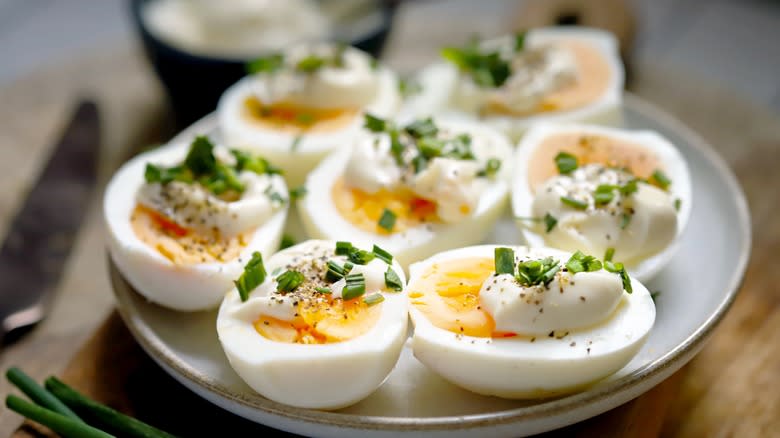
Eggs are an incredibly versatile, inexpensive, delicious, and nutritious snack or meal. While there are countless ways to prepare them, hard-boiled eggs are one of the best choices when it comes to meal prepping ahead of time or helping round out an incomplete meal quickly.
They can be enjoyed simply with just a sprinkle of salt or something more assertive like hot sauce or mustard. They can be sliced and stuffed inside a sandwich, whipped into egg salad, or even prepared for company into an always popular deviled egg. Boiled eggs can be stored unpeeled in the refrigerator for up to one week, making it that much faster and easier to enjoy them. There are a lot of great tips available for cooking a perfect hard-boiled egg, but even an experienced cook can struggle when it comes time to slice, split, or chop them up. Luckily there are some easy and helpful tips that can help alleviate that stress.
Read more: Hacks That Will Make Boiling Your Eggs So Much Easier
Cool It Down
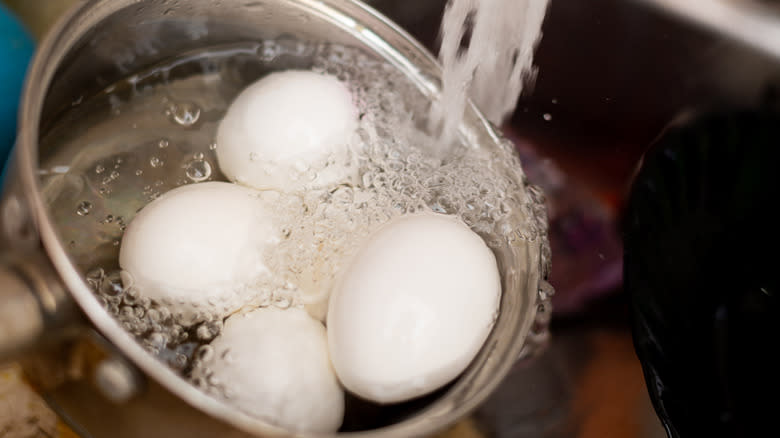
Sometimes it's what you do before peeling your eggs that makes cutting them easier. Once the egg is cooked, it needs to be transferred to a bowl of ice water for about 10 to 15 minutes. If the water warms up and/or all the ice melts, simply add more ice or change out the water. Even if the egg shell feels cool after just a few minutes, don't be tempted to skimp on the timing as it takes several more minutes for the center of the egg to fully cool.
This is a critical step for a few reasons. First, eggs will continue to cook after being removed from the hot water so if they are not rapidly cooled down to stop the cooking process, a perfectly set and creamy egg yolk can become overcooked making it dry, crumbly, and extra difficult to cut. Second, when the egg quickly cools in ice water, it will contract inside the shell, making it easier to remove the shell without taking half the egg white with it. The eggs do not need to be ice cold, but room temperature at a minimum will make them easier to work with.
Use A Sharp Knife
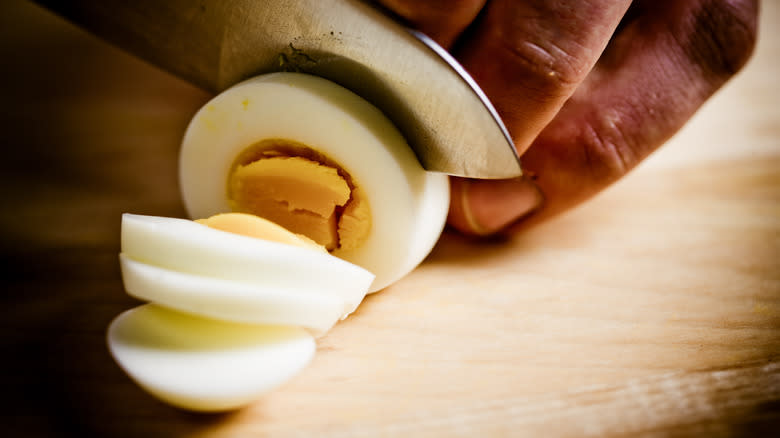
It might be easy to grab the butter knife you just used for the toast to cut up an egg, but for clean cuts and slices, you need the sharp smooth blade of a chef's knife. While a serrated knife is a good second choice, the little teeth can rip the delicate egg and leave marks in the whites. It's a minor detail but if entertaining, it may be unwanted. A dull knife will leave bits of egg clinging to it or worse, cause the egg to roll away from you risking a cut.
For slicing or halving an egg, make sure the knife blade is clean, and then pull lengthwise through the egg with moderate pressure rather than pressing down on the egg -- which can cause the egg white to bounce back and separate from the yolk. If the knife does pick up any bits of egg as you work, give it a quick rinse and wipe to keep it clean between cuts. If it's hard to slice your egg that might be a good indicator it's time to sharpen your knife.
Sometimes Cutting The Egg Isn't Necessary
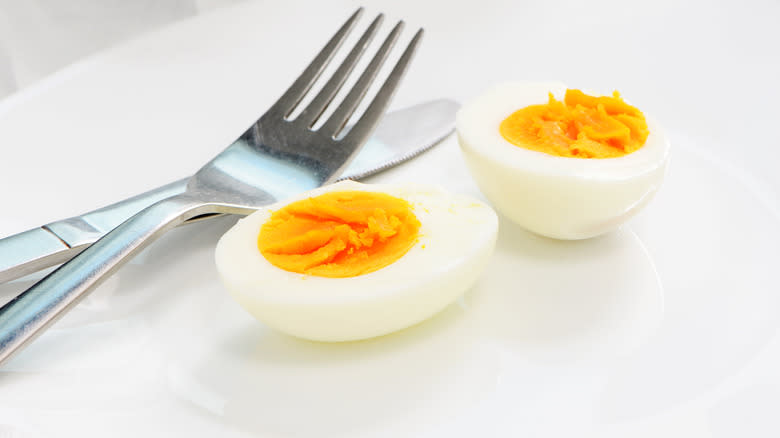
Not all recipes need a precisely cut or sliced egg and these are the times you can look for a more rustic way to cut your egg. For topping toast or a bowl of savory oats, a fork or spoon is more than capable of the job.
Simply place the whole peeled egg on the crusty bread or in your bowl and break it apart into the desired size pieces. From there, it can be mashed lightly into the toast so it doesn't fall off or stirred into the warm oats. This is especially easier if the yolk still has a bit of a jammy texture to it. Not only will there be no messy transfer from cutting board to dish, but the softer set of the yolk would be more challenging to slice with a knife without breaking apart. The craggy irregular edges will also hold onto any seasoning you sprinkle on top so it's a double win for perfect seasoning and ease of preparation.
Separate The Eggs Before Chopping
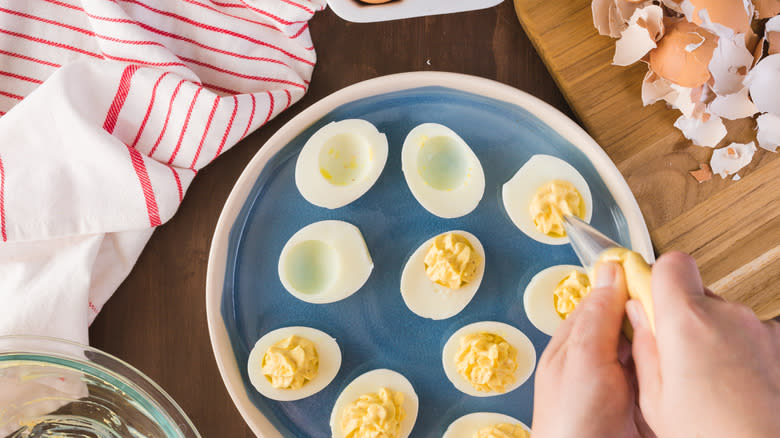
The textures of egg whites and yolks vary drastically, so sometimes, the best strategy is to divide and conquer. If chopping eggs for a dish, such as a potato salad or egg salad, in which the egg will get tossed and mixed up anyway, there is little reason to labor over keeping the egg parts together and intact while chopping.
Egg whites are springy and firm, while the rich yolks can be crumbly, sticky, or slick, depending on the doneness of the egg. To make chopping easier, faster, and tidier, halve a peeled, cooked, and cooled egg and scoop the yolks into a bowl. Set the halved whites, flat side down, on a cutting board and slice or chop into the desired size. Then, repeat with just the yolks, chopping them less precisely as they will crumble a little more once tossed. It is better to start with the whites as they do not dirty a knife, so there is no need to clean as you go.
Make One Large Egg Cake
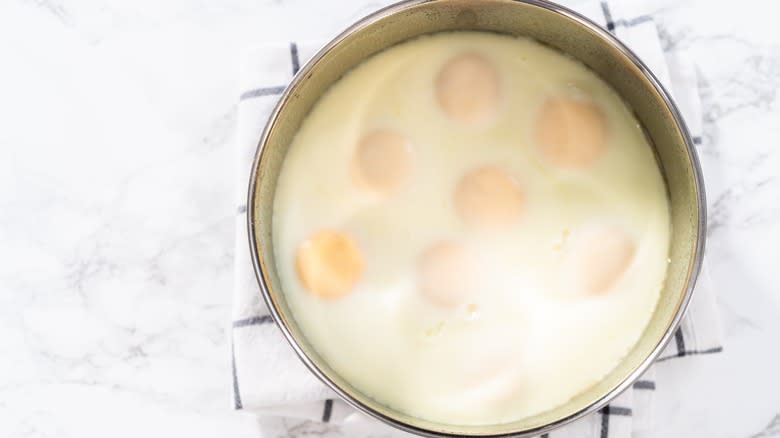
An electric pressure cooker has become a staple kitchen appliance, and using it to cook eggs is one of the most popular uses. While a lot of pressure cooker egg content covers the best way to cook hard-boiled eggs in the shell, you can make things even easier than that.
The base of the hack involves cooking eggs as one large "cake." Using a small pan that fits inside the pressure cooker, crack as many eggs as desired right into the pan, seal the pressure cooker, and set the timer. Once the time is up and the pressure released, the eggs will have cooked into one solid piece, ready to be turned onto a cutting board and chopped up to whatever size is needed.
This method makes cutting hard-boiled eggs easier in two ways. The first is that it skips a lot of the prep work. There is no need to worry about peeling all those shells only to be left with a pile of slippery ovals. Second, the eggs will be uniformly cooked. All the whites and yolks will have similar doneness and, therefore, the same texture. There is no need to worry that one egg will be chalky and crumbly and the other jammy and sticky, leaving a mess in either scenario.
Choose A Different Tool When Precision Doesn't Matter
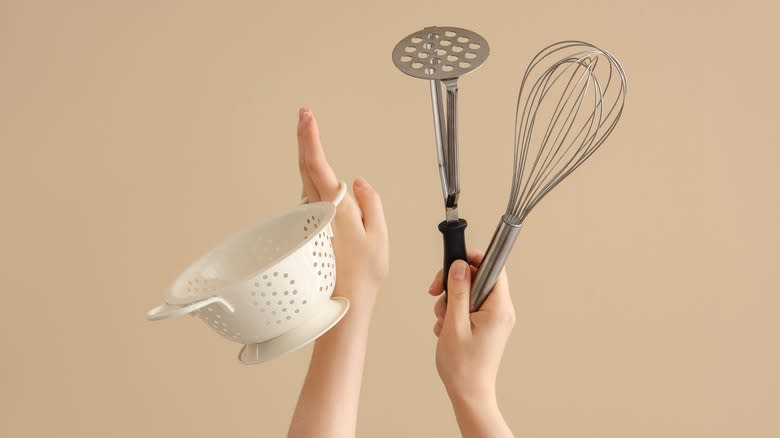
Some recipes, like egg salad, don't need perfectly chopped pieces of egg. A mixture of different-sized pieces of white and lightly crushed yolks can improve the recipe by adding texture while letting the yolks lightly bind the salad. In this instance, it is easier to consider mashing the eggs instead of cutting them, and there are a few tools many already own that are perfect for this.
For a more rustic chop, grab a potato masher. There is no need to halve the eggs first. Add your peeled eggs to a bowl and gently begin to smash. The size of the pieces will initially be determined in part by the design of the masher. A wavy line-designed masher versus a grid pattern masher will initially create different sizes, but the more you mash, the finer the end result. A stiff whisk is also a great choice because the thin tines will easily cut through a soft egg, though you may need a firm tap and a spatula to clear all the eggs from the inside of the whisk. It will make fast work of breaking down the eggs into small pieces.
Try A New Technique
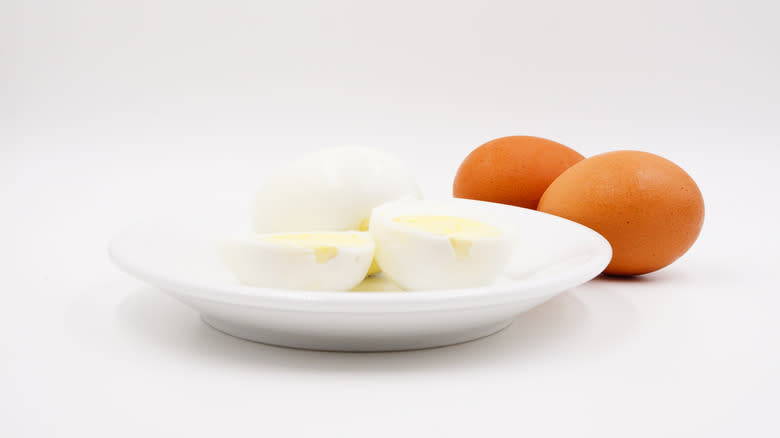
Recently, a technique for halving hard-boiled eggs became wildly popular on TikTok for its apparent ease and beautiful result. The basic idea is that you cut just deep enough into a whole hard-boiled egg to get through the white, but not into the yolk. Then, you pull back on the knife with steady light pressure so the egg rolls in a full circle and falls apart into two even halves. The yolk either falls out on its own in one perfect round or can be gently prodded out, leaving you with a clean knife and separated eggs ready to chop.
Because the knife never lifts up, the egg whites have a smooth, even surface and are the same size. This makes it easy to lay them cut down and quickly work through a bunch of egg-white pieces, yielding similarly-sized chunks without having the halves wobble or roll away. Since you are not pressing through the yolks when separating the eggs, the knife stays clean, as does the inside of the egg. With practice, it becomes quick work to get through a pile of eggs and gives the option to keep the halves in one piece or chop them down into smaller pieces.
Go Old School With An Egg Slicer
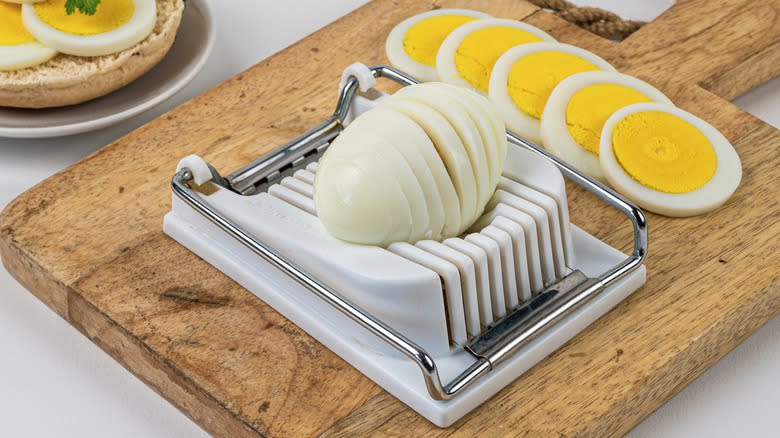
When perfect slices are in order, this gadget was quite literally made for the job. The basic design has an egg-sized oval-shaped divot set into a plastic rectangle for the bottom, while the top piece has a series of firm, thin wires running from one end to the other. The two pieces are secured by a hinge on one end.
Place the egg in the bottom divot, which keeps it from rolling around, and press the top piece over the egg. The wires create perfect, evenly-sized slices. You can turn these slices into smaller pieces by gently rotating the sliced egg 90 degrees and cutting them again. Then, dump the egg pieces in a bowl. It is practically hands-free while also being incredibly consistent at cutting eggs among other food items, like strawberries, avocados (obviously once out of the shell), and soft cheeses.
Put The Tools Down And Use Your Hands
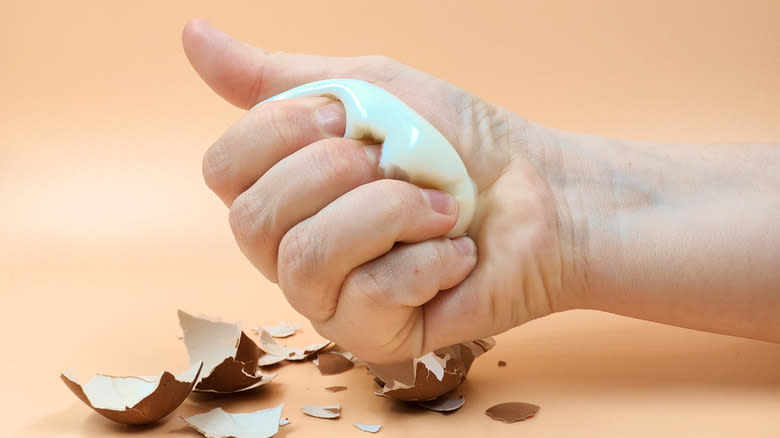
Luckily, hard-boiled eggs are a perfect ingredient for getting your hands in the mix. There are, obviously, several methods of preparing eggs for egg salad, and one way you might not have thought of is to hand-crush the eggs. While maybe a little messier than other ways of cutting or mashing eggs, the idea is that it's easier to control the finished result by tearing and breaking them with your hands.
Other tools dictate the size and shape of the crushed or sliced egg, but using your hands allows you to apply different amounts of pressure to the dense yolks versus the lighter whites to create a more customizable texture. You can leave some yolks in pieces while pressing others into a paste to bind the recipe ― a feat not easily achieved with a knife. This method may be a little more fun and unconventional, but note that it is not ideal if hoping for tidy pieces that all end up the same size.
Stabilize The Eggs
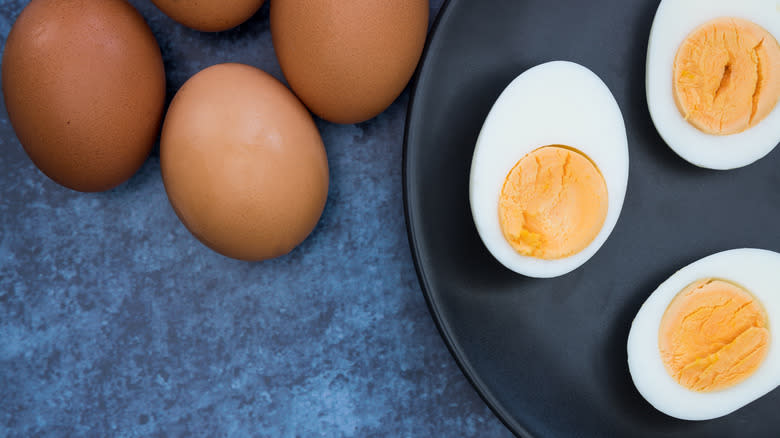
Between the fact that hard-boiled eggs are both slippery and round, they can inherently be tricky to wrangle. Halving a few is one thing, but if you have a decent amount to chop down into small pieces, try this tip from the same handy trick that keeps filled deviled eggs from rolling around and creates a flat base on one side.
After the egg is peeled, take a thin slice off of the white on one side and lay it flat side down to create a stable bottom. The egg is now less likely to move around when cutting. Not only can this protect your fingers from unwanted cuts, it helps ensure you get the slice or dice you are after in the first place. Plus, you can chop and add the small egg white slices to your recipe or keep them in the fridge for a few days to toss into a salad, so there is no waste.
Grip The Eggs With An Onion Holder
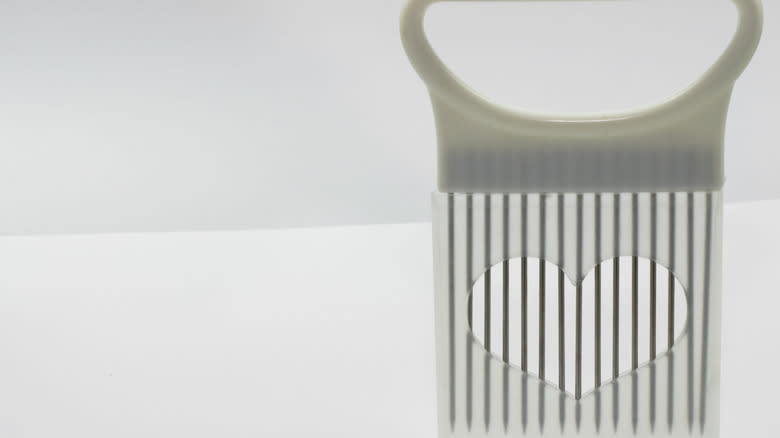
If you have never seen an onion holder before, it might quickly be mistaken for a hair comb. This tool has a row of long, skinny metal tines attached at the top to a flat handle. Crafted for onions, the tines are pressed into a whole or halved onion, which keeps the slippery round in place on a cutting board so it doesn't move when you chop it. The holder also keeps your fingers clean and odor-free because you don't actually have to touch the onion. Think of it as the vegetable equivalent of a meat fork.
The simple design and purpose lend themselves well to helping make cutting easier on a wide assortment of round or slippery ingredients, including hard-boiled eggs. The thin tines sink into an egg without much effort, lengthwise or crosswise, to keep it steady while cutting. The even spacing between the tines can also mark where to cut to create identically sized cuts. These aspects make cutting hard-boiled eggs faster, more precise, and tidier.
Lightly Oil Your Knife
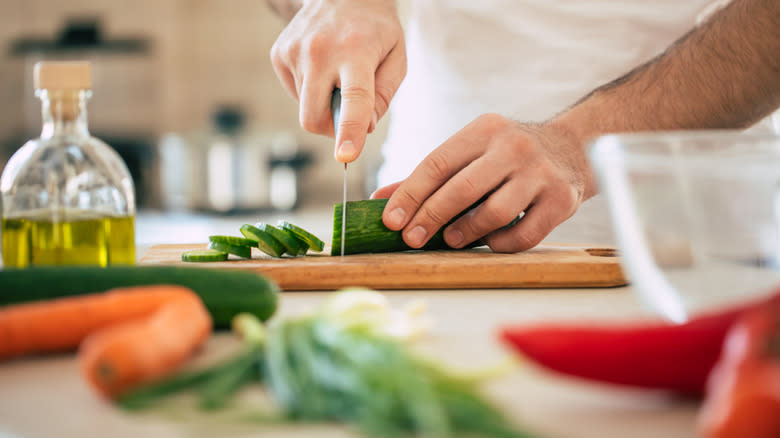
While a sharp knife is ideal, if you are caught with a duller blade than anticipated, a light bit of oil or cooking spray on the knife blade can make chopping an egg easier. The oil will create a nonstick barrier between the metal and the egg, so regardless of the cook on the yolk, it will be less likely to stick to the blade, resulting in a cleaner and easier chopping process.
Choose a neutral oil to avoid adding unwanted flavor to the eggs. If using a cooking spray, add a very light touch to only the blade so the handle does not become slippery. Wipe any excess oil off by blotting, pressing, or gently wiping against a kitchen towel on a work surface and not with your hands. For liquid oil, pour a few drops on the blade before gently wiping against a kitchen towel to evenly and lightly coat the knife blade. After chopping, clean off any excess oil to avoid any sticky or greasy buildup on the knife.
Read the original article on Tasting Table.

